By Ana Rodriguez Soto - Florida Catholic newspaper
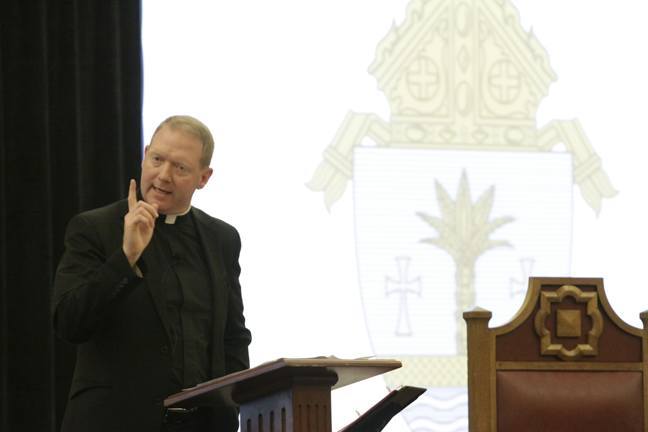
Photographer: ANA RODRIGUEZ-SOTO | FC
Father Patrick Beidelman of the Archdiocese of Indianapolis goes over the whys and the how-tos of the new English translation of the Roman Missal.
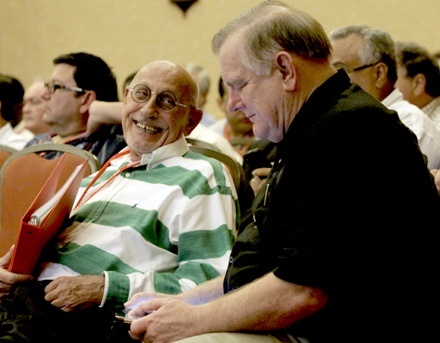
Photographer: ANA RODRIGUEZ-SOTO | FC
Father Roger Holoubek, pastor of St. Maurice in Dania Beach, shares a laugh with Archbishop Thomas Wenski during one of the sessions of the priests' convocation.
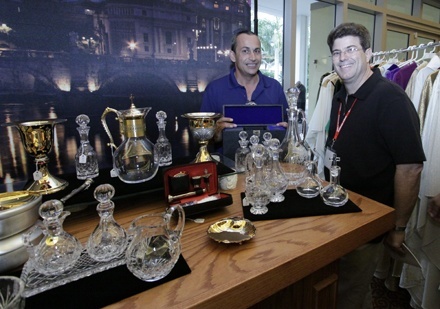
Photographer: ANA RODRIGUEZ-SOTO | FC
Father Francisco "Paco" Hernandez, pastor of Immaculate Conception Church in Hialeah, checks out chalices and other liturgical items with exhibitor Ramon Gonzalez of All Church Products and Services.
Photographer: ANA RODRIGUEZ-SOTO | FC
Msgr. Jude O'Doherty, pastor of Epiphany Parish in South Miami, checks out the cassocks exhibited by vendors at the convocation.
That was the advice given by a liturgical expert, Father Patrick Beidelman, to archdiocesan priests during their annual convocation Sept. 27-29. Father Beidelman is director of liturgy for the Archdiocese of Indianapolis, and he spoke to the nearly 250 active priests of the archdiocese regarding the upcoming implementation of the new English translation of the Roman Missal.
Parishes have permission right now to use the new words of the peoples’ responses if these are sung. The entire new wording will come into use with the start of the new liturgical year Nov. 27, the first Sunday of Advent.
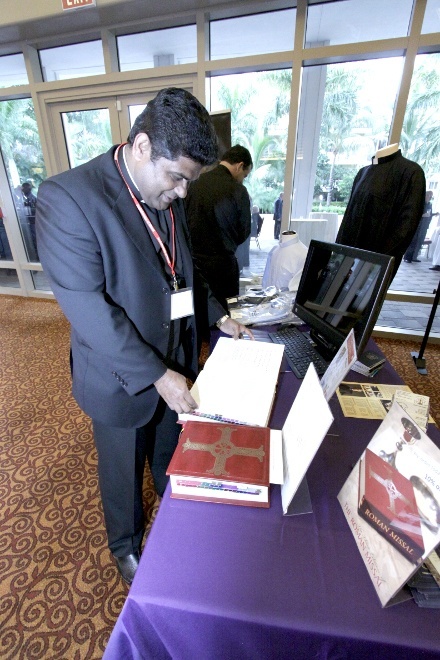
Photographer: ANA RODRIGUEZ-SOTO | FC
Father George Packuvetthara, parochial vicar at St. David Church in Davie, checks out the new English translation of the Roman Missal.
“This is very much about a change of words, not a change of rubrics,” Father Beidelman said, referring to the actions of the priest during Mass. But he did caution them, “Don’t assume that you’ve been doing it right all these years. … Do read the prayers beforehand.”
He encouraged the priests to “welcome (the changes) with a good spirit and invite parishioners to do it as well.”
Don’t look at it as another task, he said, but as an opportunity “to strengthen our practice in glorifying God and striving for sanctification.”
In fact, he suggested, “spend 20 percent (of your time) helping people say the new words and 80 percent helping people grow in their understanding of the Mass.”
The reason the Church has a new translation is simple, Father Beidelman said: “Because two popes, Pope John Paul II and Pope Benedict XVI, looked at the various translations of the Roman Missal around the world over a number of years, and they thought it could be done better. That’s it. The Holy Father is doing his job.”
Father Beidelman stressed that it is not only the English translation that is being revised. “Everybody else in the world is doing this too.”
He cautioned against “politicizing” the changes, or viewing the earlier ones as somehow incorrect.
The fact is, “You can’t translate exactly from one language to another,” Father Beidelman said. For hundreds of years, when the Church has used the vernacular, “we have chosen the best of the imperfect and we move forward.”
Given the speed with which the original English translation was completed in 1973, and the lack of guidelines from Rome at the time, everyone knew improvements were needed. A second English translation was issued 12 years later — the one currently in use — and a third was issued 12 years after that, in 1997.
But by then, Pope John Paul II had decided to change the translating rules. In 2000, he issued a third Latin edition of the Roman Missal and a document called “Liturgiam Authenticam” in which he called for “literal exactness” in translation, rather than the previous standard, “dynamic equivalency.”
These new rules move the Mass prayers and responses “away from everyday language to a sacred style of speaking,” Father Beidelman said.
The new missal also is much bigger than the current one, with additional prefaces, Masses for 17 newly canonized saints and many more Marian feasts, and Masses for various needs and intentions, such as respect for human life.
“I would encourage you to look at those and use them,” Father Beidelman told the priests.
He also told them to always be aware of the “awesomeness of the gift” they have received in being able to celebrate the Mass, and “the depth of our unworthiness.”
Their approach to the Mass, Father Beidelman said, should always be: “By our bearing, by the way we pronounce the words, how can we better convey to our faithful the divine presence of God?”
One archdiocesan priest who said he is really excited about the changes is Father Chris Marino, pastor of St. Michael the Archangel Parish in Miami.
“I’m delighted with the new translation. I’m a big liturgy guy and I’ve been waiting for this,” Father Marino said as he handled the new missal for the first time.
He said his parishioners began singing the new responses as soon as permission was granted this September.
“We sing everything. Everything is chanted except for the readings themselves, so everything we are allowed to use we have been using,” Father Marino said.
The singing helps the people learn the new words, and “it’s working at St. Michael,” he added, although, “I don’t know what’s going to happen when we don’t sing it.”
Aside from learning about the new missal, priests at the convocation took part in daily Mass with Archbishop Thomas Wenski, said morning and evening prayer together, were introduced to new senior staff members at the Pastoral Center and listened to the archbishop’s “state of the archdiocese” talk.
They also had plenty of time to relax and catch up with each other.
“We don’t have this opportunity that often to have this time of fraternity,” Archbishop Wenski said.
As Father Marino put it: “I’m a priest of the Archdiocese of Miami and I’m a son to the bishop and a brother to the brothers. It’s always good to be with your family.”
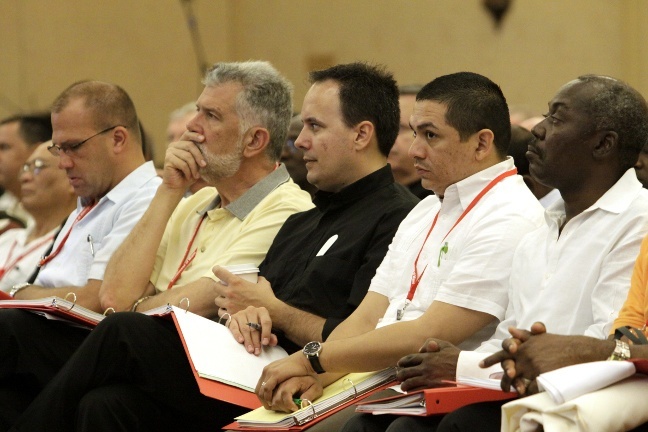
Photographer: ANA RODRIGUEZ-SOTO | FC
Priests listen as Father Patrick Beidelman explains the history behind the new English translation of the Roman Missal, which will come into use this Advent in all the parishes of the United States.


Comments from readers
This is a great opportunity to instill in people ¨holy reverence¨while they are in the church. So much needed. Acknowledgement of the ¨Real Presence¨of Our Lord in the Eucharist starts with silence and reverent postures .
May God bless all the priests and we are very grateful for their service.